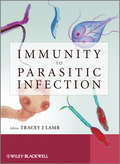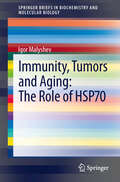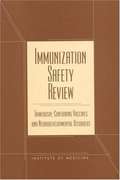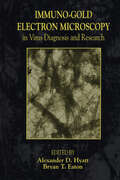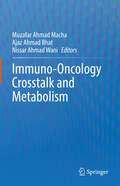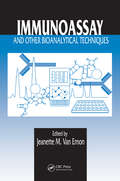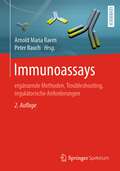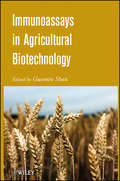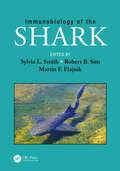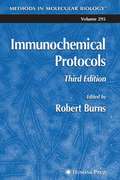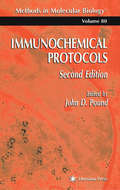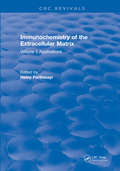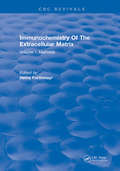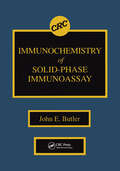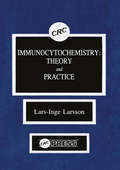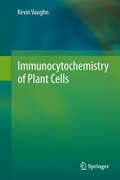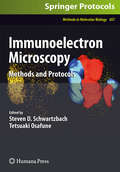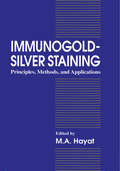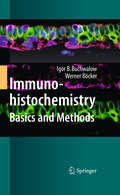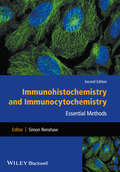- Table View
- List View
Immunity to Parasitic Infection
by Tracey LambParasitic infections remain a significant cause of morbidity and mortality in the world today. Often endemic in developing countries many parasitic diseases are neglected in terms of research funding and much remains to be understood about parasites and the interactions they have with the immune system. This book examines current knowledge about immune responses to parasitic infections affecting humans, including interactions that occur during co-infections, and how immune responses may be manipulated to develop therapeutic interventions against parasitic infection.For easy reference, the most commonly studied parasites are examined in individual chapters written by investigators at the forefront of their field. An overview of the immune system, as well as introductions to protozoan and helminth parasites, is included to guide background reading. A historical perspective of the field of immunoparasitology acknowledges the contributions of investigators who have been instrumental in developing this field of research.
Immunity, Tumors and Aging: The Role of HSP70
by Igor MalyshevThe book is dedicated to the topical area of biology and medicine and the role of stress proteins HSP70 in the regulation of intracellular protein homeostasis, signaling transduction and cell protection. The book is divided into chapters, which describe the discovery of HSP70 and its molecular structure, the mechanism of the synthesis and function in normal and damaged cells, examine the role of HSP70 in immunity, cancerogenesis, aging, Alzheimer's disease and cardiac surgery. In this book, the author looks at HSP70 as a factor which prevents the transformation of homeostasis mechanisms of intracellular proteins into a link in the pathogenesis of a disease.
Immunization Safety Review: Thimerosal-containing Vaccines And Neurodevelopmental Disorders
by Institute of MedicienInformation on Thimerosal-containing Vaccines And Neurodevelopmental Disorders
Immuno-Gold Electron Microscopy in Virus Diagnosis and Research
by Alexander D. Hyatt Bryan EatonThis book presents a wide variety of immuno-gold techniques for use in virus diagnosis and research. Protocols are presented for state-of-the-art techniques, including in situ hybridization, freeze substitution, and the utilization of ultra-small probes and replicas for use by virologists and electron microscopists identifying and studying viruses, their components, and replication in cells. The procedures are described by eminent scientists and are pertinent to both experienced researchers and newcomers to this field who are interested in the localization of low antigenic mass structures.
Immuno-Oncology Crosstalk and Metabolism
by Muzafar Ahmad Macha Ajaz Ahmad Bhat Nissar Ahmad WaniThis book discusses the novel metabolic cross-talk between immune and tumor cells in the tumor microenvironment that promotes their growth and progression. It also describes deregulated metabolism in cancer cells that promotes suppressive and cancer cell-favourable microenvironment. Further, the book provides novel insights on the metabolic changes in immune cells that promote tumor cell growth and survival. In turn, it also reviews the involvement of immuno-onco metabolic cross-talk in the development of resistance to chemo-radiation therapy (CRT) in tumor cells. Lastly, it also explores the potential of immuno-oncology metabolism as a therapeutic approach against tumor cells.
Immunoassay and Other Bioanalytical Techniques
by Jeanette M. Van EmonTaking an interdisciplinary approach that emphasizes the adaptability of immunochemical and related bioanalytical methods to a variety of matrices, Immunoassay and Other Bioanalytical Techniques describes the strength and the versatility of these methods in a wide range of environmental and biological measurement applications. With contribut
Immunoassays: ergänzende Methoden, Troubleshooting, regulatorische Anforderungen
by Arnold Maria Raem Peter RauchDieses Methodenbuch vermittelt eine gut lesbare, fundierte Einführung in die Grundprinzipien immunologischer Methoden. Wissenschaftler*innen der Naturwissenschaften und Medizin wie auch TAs können sich einen ersten, grundlegenden Einblick in die Durchführung der verschiedenen Immunoassays verschaffen und werden dabei über deren unterschiedliche Einsatzbereiche informiert. Jedes Kapitel in Immunoassays beginnt mit einer grundlegenden Einführung in die Thematik, bevor auch für den Laboralltag und die berufliche Praxis wichtige Details abgehandelt werden. Die Leser*innen erlangen mit dieser Lektüre Sicherheit beim Einsatz der Methoden im Laboralltag, da auftretende Probleme und was man dagegen tun kann im Detail besprochen werden. Hierbei sind die zahlreichen Tipps aus der Praxis sehr wertvoll. Besonders hervorzuheben in diesem Buch sind die akkuraten und funktionierenden Rezepte. Durch ihre tagtägliche Arbeit mit Immunoassays verfügen die Autoren wie auch die Herausgeber über einen reichen Erfahrungsschatz mit diesen Methoden. Eine rundum hilfreiche Lektüre für Einsteiger und erfahrene Praktiker.
Immunoassays in Agricultural Biotechnology
by Guomin ShanA very broad range of professionals are using immunoassay technology daily to analyze genetically engineered (GE) crops and related areas, and many of these professionals are completely new to this technology. There is a great need for users to have a book containing technical and practical guidance, and describing limitations and pitfalls of applying immunoassay in agricultural biotechnology.This book focuses on the application of immunoassays to GE plants and related areas. A group of international experts from government agencies, academics and industries, who have many years of related experience, contribute high quality chapters in their areas of expertise. This book covers topics including principles of immunoassay, antibody engineering in AgBiotech, current technologies (formats, kit development, manufacturing and quality control), method validation, applications in trait discovery and product development, applications in grain products and food processing, applications in environmental monitoring, automation and high throughput, reference materials, data interpretation and source of error, and future perspectives and challenges. In addition, to meet the practical needs for a variety of readers from different backgrounds, methods and protocols are included as well.
Immunobiology of the Shark
by Sylvia L. SmithSharks belong to the oldest vertebrate species that possess immune systems similar to that of mammals. This makes them a great model species to study the fundamentals of the mammalian immune system. This book describes the cellular, genetic, and molecular specifics of immune systems in sharks and uses them to understand shark immunity as well as the evolution of immune systems in more recently-evolved vertebrates. Written by global experts, the book will be a resource for immunologists, geneticists, ecologists, evolutionary and conservation biologists, and investigators engaged in shark research.
Immunochemical Protocols
by Robert BurnsThis new edition of a much praised classic includes both basic method for producing and using antibodies and advanced techniques required by today's state-of-the art investigators. The basic sections of the book stress the first principles of antibody production and guide the reader through the processes and pitfalls of immunochemistry. The advanced sections focus on specific applications and cover the immunochemical techniques now used in laboratories. New material includes techniques for making new monoclonal cell lines, for producing good quality monoclonal antibodies, immunocapture PCR, immunoaffinity purification, and immunoelectron microscopy in plant virus diagnosis.
Immunochemical Protocols
by John PoundThis much anticipated second edition provides a user-friendly, up-to-date handbook of reliable immunochemical techniques optimized for molecular biologists. It covers the breadth of relevant established methods from protein blotting and immunoassays through to visualization of cellular antigens and in situ hybridization, each with their latest refinements. Protocols for the production and purification of important classes of immunochemical reagents are also provided, including "conventional" and recombinant antibodies, fusion proteins and their various conjugates. This book will open the door to a new generation of immunochemical reagents with exciting possibilities.
Immunochemistry Of The Extracellular Matrix: Volume 2
by FurthmayrThe main purpose of the two volumes on Immunochemistry of the Extracellular Matrix is to describe state of the art methods, which have been proven to provide antibody reagents of defined specificity to collagens as well as other glycoproteins found in association within connective tissue. The isolation and purification of collagens, procollagens, and related connective tissue proteins are described for several tissues, tissue culture cells and species. Immunization with these collagens in laboratory animals yields antibodies with different characteristic specificities: to the procollagen extension fragments, the non-helical segments of the a-chains, to helical and denatured determinants.
Immunochemistry Of The Extracellular Matrix: Volume 1
by FurthmayrThe main purpose of the two volumes on Immunochemistry of the Extracellular Matrix is to describe state of the art methods, which have been proven to provide antibody reagents of defined specificity to collagens as well as other glycoproteins found in association within connective tissue. The isolation and purification of collagens, procollagens, and related connective tissue proteins are described for several tissues, tissue culture cells and species. Immunization with these collagens in laboratory animals yields antibodies with different characteristic specificities: to the procollagen extension fragments, the non-helical segments of the a-chains, to helical and denatured determinants.
Immunochemistry of Solid-Phase Immunoassay
by John E. ButlerImmunochemistry of Solid-Phase Immunoassay fills a niché in the field of immunoassay and immunology. Although solid-phase immunoassay constitutes a major technology in biology and medicine, there is no comprehensive source devoted to the immunochemical principles involved. As a result, this book will benefit students, technicians, and researchers who use this technology, as well as immunodiagnostic and biotech companies who develop the technology. The book is not a methods manual; instead, it incorporates the concepts, data, and opinions of more than 25 investigators working in this field. Topics discussed include: the chemistry of solid-phases, the behavior or antibodies and antigens on solid phases, membrane solid-phases, reaction kinetics, antigen quantitation, enzyme systems, photophysics, immunochemical considerations in data analyses, multianalyte assays and occupancy concepts, antibody quantitation, streptavidin, a review of data analysis software, and solid-phase peptide immunoassay.
Immunocytochemistry
by Richard W. BurryDescription: In biomedical research, because of a dramatic increase in productivity, immunocytochemistry has emerged as a major technique. The proposed book will provide the first practical guide to planning, performing, and evaluating immunocytochemical experiments. In today's graduate education the emphasis is on doing research and not on formal class work. Graduate students therefore lack the background in many essential techniques necessary to perform research in fields in which they were not trained. As director of a university core microscopy facility which sees students and faculty from dozens of laboratories each year, Dr. Burry has surmised the vast majority of these novice microscope users need considerable help. In an attempt to educate users, Dr. Burry has initiated immunocytochemistry seminars and workshops which serve to train people in this powerful research tool. The proposed book is an outgrowth of these presentations and conversations with, by now, hundreds of people who have asked for help. The philosophy which separates this book from other books in this field is that it is practical, rather than academic. In looking at other important immunocytochemistry titles, the predominant orientation is academic, with the author attempting to comprehensively discuss the topic. For example, one book with sample preparation lists ten fixatives which can be used; however, only two such fixatives are commonly used today. In this particular title, the detailed discussion of old methods might be seen as important in establishing the author as an expert. By contrast, the approach for Burry's book would be to discuss methods based on what works in animal research laboratories today, and focus only on the most productive methods. An additional distinction with this proposed book is the focus on animal research and not human pathology. There is a certification program for pathology technicians which requires them to learn a set body of material based on processing human tissue for examination by a pathologist. Many of the books on immunocytochemistry aim at this large pathology user base. Due to historical reasons, pathology laboratories process human tissues in a specific way and embed the tissue in paraffin, as has been done for over a century. In the last ten years, the power of immunocytochemistry in clinical diagnosis has become clear and has accordingly been adapted to pathology. However, the extensive processing needed for paraffin sections is not needed if the tissues are from research animals. Processing for animal-based tissues takes about a third of the time and results in higher quality images. The focus of this book is on processing these animal research tissues for immunocytochemistry. Today, there are no technique books which are aimed at this user base. As a subject matter expert in the area of the proposed book, Dr. Burry will make recommendations and offer opinions. Because this field is new and is emerging, there are numerous advantages of specific methods over other, more generalized methods. The purpose of this book is to show a novice how to do immunocytochemistry without engaging in a discussion of possible advanced methods. For the advanced user, there are several good books which discuss the unusual methods, yet for the novice there are currently none. Main Author : Richard W. Burry, The Ohio State University (United States). The Outline of the Book : Each chapter supplies a set of important principals and steps necessary for good immunocytochemistry. The information is distilled down to include only the most important points and does not attempt to cover infrequently used procedures or reagents. At the end of most chapters is a section on trouble-shooting many of the common problems using the Sherlock Holmes method. Each chapter also includes specific protocols which can be used. The goal of each chapter is to present the reader with enough information to successfully design experiments and solve many of the problems one may encounter. Using immunocytochemical protocols without t...
Immunocytochemistry: Theory and Practice
by Lars-Inge LarssonA complete and balanced overview of all aspects of immunocytochemistry is presented providing a clear understanding of their impact on experiment. All available techniques and many diagnostic and research applications are included, as well as practical step-by-step instructions for carrying out recommended methods. Intended for the novice as well as the experienced researchers.
Immunocytochemistry of Plant Cells
by Kevin VaughnImmunocytochemistry of plant cells is the first book exclusively dedicated to this topic. The first and largest portion of the book is concerned with a group of proven protocols and variations on these protocols that might prove useful, many developed or modified in the author's laboratory. The second portion of the book covers the studies that have been published previously on each of the plant organelles. Numerous state of the art micrographs from researchers around the world are included to demonstrate typical results.
Immunodiagnosis of Cancer
by M.d d.Updated to reflect changes in the field since publication of the first edition in 1979. Provides a detailed review of the methodology available for assessing the diagnosis and prognosis of cancer patients including data on the application of tumor marker assays and other immunodiagnostic procedures
Immunodiagnostic Technologies from Laboratory to Point-Of-Care Testing
by Pankaj Suman Pranjal ChandraThis book presents the timeline of immunodiagnostics evolution, including advancements in immunological/nucleic acid probes, assay design, labelling techniques, and devices for signal transduction and acquisition. In the past few years, enzyme and nanocatalyst-based immune assays have undergone numerous modifications to enhance their sensitivity and potential for automation. Further, to reduce production costs and the use of laboratory animals, engineering small antibodies and nucleic acid probes (aptamers) has become increasingly popular in the development of novel and powerful bioassays. In light of the notable advancements in immunodiagnostics, this book highlights the combined efforts of clinicians, biotechnologists, material scientists, nanotechnologists and basic scientists in a coherent and highly structured way. The book takes readers on the journey of immunodiagnostic technologies, from their introduction to the present.
Immunoelectron Microscopy
by Steven D. Schwartzbach Tetsuaki OsafuneImmunoelectron microscopy is a key technique that bridges the information gap between biochemistry, molecular biology, and ultrastructural studies placing macromolecular functions within a cellular context. In Immunoelectron Microscopy: Methods and Protocols, expert researchers combine the tools of the molecular biologist with those of the microscopist. From the molecular biology toolbox, this volume presents methods for antigen production by protein expression in bacterial cells, methods for epitope tagged protein expression in plant and animal cells allowing protein localization in the absence of protein specific antibodies as well as methods for the production of anti-peptide, monoclonal, and polyclonal antibodies. From the microscopy toolbox, sample preparation methods for cells, plant, and animal tissue are presented. Both cryo-methods, which have the advantage of retaining protein antigenicity at the expense of ultrastructural integrity, as well as chemical fixation methods that maintain structural integrity while sacrificing protein antigenicity have been included, with chapters examining various aspects of immunogold labeling. Written in the highly successful Methods in Molecular BiologyTM series format, chapters include introductions to their respective topics, lists of the necessary materials and reagents, step-by-step, readily reproducible laboratory protocols, and notes on troubleshooting and avoiding known pitfalls. Authoritative and essential, Immunoelectron Microscopy: Methods and Protocols seeks to facilitate an increased understanding of structure function relationships.
The Immunogenetics of Dermatologic Diseases (Advances in Experimental Medicine and Biology #1367)
by Nima Rezaei Fateme RajabiThis book intends to investigate the broad spectrum of genetic changes in immunological processes involved in cutaneous diseases. One of the main goals of immunogenetic studies is finding susceptibility genes for complex diseases. This can provide an insight into the pathogenesis of the condition in a way that is not easily achievable through other kinds of studies. Thus they are a rational initial step for generating hypotheses about disease pathogenesis. This may especially benefit dermatology, a field notorious for having too many diseases with unknown etiologies.Immunogenetic investigations have made targeted treatment strategies possible for diseases such as psoriasis and pemphigus. Even though these strategies have revolutionized the management of chronic dermatological conditions such as psoriasis, still there are a lot of unanswered questions. For instance, psoriasis patients respond very differently to each of the commercially available biological agents. This diversity could be partially explained by the differences in the sets of genes responsible for disease induction in each individual. Thus whole genome sequencing strategies, if feasible at individual levels, might help in tailoring these targeted treatments based on specific genetic backgrounds.Our intention in preparing this book was to explore the broad spectrum of the genetic aspects of immunological processes involved in cutaneous diseases. We have tried to cover most areas of dermatology where enough studies were available to gather a chapter. Still, there is a substantial lack of knowledge on the immunogenetics of many dermatological conditions. We hope that this book would encourage the investigators to fill these gaps of knowledge.
Immunogold-Silver Staining: Principles, Methods, and Applications
by M. A. HayatThis book discusses the principles, methods, and applications of immunogold-silver staining (IGSS) to biomedical areas. It focuses on the latest advances in the dynamic and progressive field of IGSS.
Immunohistochemistry: Basics and Methods
by Igor B. Buchwalow Werner BöckerWhile many excellent texts and monographs exist which cover various aspects of immunohistochemistry, the lack of a concise comprehensive guide to using the field's methods was a major motivation for the authors to write this book. The authors carefully selected the methods and easy-to-adopt protocols discussed. In addition to estabished techniques, special attention was paid to current developments in immunohistochemistry such as antigen retrieval, signal amplification, the use of epitope tags, multiple immunolabeling, and diagnostic immunohistochemistry. All procedures examined have been tested by the authors; many are routinely used in daily practice in their institute. Each chapter starts with a short introduction to the respective method's underlying principles before presenting step-by-step protocols and instructions, including precise recipes for all materials needed. Thus, the book is suitable for a broad audience, ranging from students and technical assistants to experienced researchers.
Immunohistochemistry
by Alexander E. KalyuzhnyAimed at both beginners and experienced researchers unfamiliar with the technique, this book provides a concise and easy-to-understand guide to using immunohistochemistry. It identifies the proper place and purpose of each component of immunohistochemistry, emphasizes the components that are of critical importance, and explains the logistics of experimental approaches. Understanding the principles of immunohistochemistry allows for the identification and localization of protein targets and is of crucial use in the following experiments: · producing transgenic animals · studying the effects of drug treatments · electrophysiological studies · animal surgery · isolating and differentiating stem cells · super-resolution microscopy Immunohistochemistry for the Non-Expert is aimed at a wide audience, including molecular biologists, pharmacologists, immunologists, chemists, cell biologists, physiologists, and researchers involved with animal anatomy studies.
Immunohistochemistry and Immunocytochemistry: Essential Methods
by Simon RenshawImmunohistochemistry and immunocytochemistry are invaluable tools for the visualization of tissue and cellular antigens in diagnostic and biological research environments. The need to obtain accurate, reliable and reproducible results is paramount. It is with this fundamental aim in mind that we have compiled Immunohistochemistry: Essential Methods. We have achieved this by examining each aspect of immunochemistry in turn, with each chapter including detailed information regarding the subject matter in question. Each chapter is written by an expert in their field and includes protocols that are typically used in their own research. Subjects covered are, amongst others, antibodies and their production; selection of reporter labels; immunochemical staining methods and experimental design (both using single and multiple reporter labels); quality assurance; automated immunochemistry; confocal microscopy and electron microscopy. In addition, benefits and limitations of each approach are discussed within the chapters.
